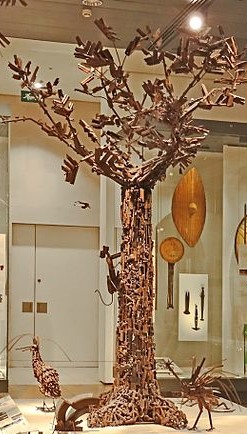Inside the British Museum, there’s a tree made of guns and grenade launchers. It’s a sculpture by four artists from Mozambique in a country moving away from war and exploitation. Citizens could exchange something deadly for ploughs, bicycles, and sewing machines. Thousands of weapons were cut up and soldered into a harrowing image of hope.
Something similar is underway in Salt Lake City. Instead of transforming physical weapons, artists are transforming copies of a book that drained people’s lives away: Spencer W. Kimball’s 1969 book, Miracle of Forgiveness, which drove a generation of gay Mormons to suicide, inauthentic marriages, and other forms of despair. In this transformation, condemnation becomes celebration.
Every Thursday throughout 2021, Kyle Ashworth of Latter Gay Stories and a volunteer army scoured Deseret Industries and other thrift stores to clear the shelves of copies of “a book that has caused immeasurable harm.” In December, Ashworth announced he was making 6,000 copies of this book available to be made into art. “We turn that pain into healing,” he said, announcing an exhibit and black-tie gala now scheduled for April 23.
Miracle of Forgiveness defines homosexuality as not just degeneracy and pathology, but a contagion leading to the deterioration of society. “I wished I hadn’t been created after reading it,” says a post on Reddit. The book was a best-seller in Mormon circles. Bishops prescribed it to sinners. Screenwriter Dustin Lance Black recalls hearing the message repeated in church. “When you’re told from the age of 8 that you’re criminal, you’re wrong in God’s eyes, that breaks your spirit.” The title of Johnny Townsend’s interlinked autobiographical short story collection is the Abominable Gayman, a reference to one of Miracle’s odder theories that Bigfoot is Cain lingering on earth. The main character, a gay man serving a mission, reads Miracle of Forgiveness again and again, trying to become straight and filling himself with self-loathing. “Everything I touched became a sin,” he despairs.
Here’s what Kimball says to anyone who deems the “evil” of homosexuality to be “incurable”: “How can you say that the door cannot be opened until your knuckles are bloody, till your head is bruised, till your muscles are sore? It can be done.” John Gustav-Wrathall, a former president of Affirmation, is one of many who say the book contributed directly to his suicidality. He took its message as a promise: “If I live faithfully, if I pray, if I study the scriptures…if I do all this stuff, it will fix this.” (Prince, pg 35) He went the extra mile in everything only to face a “shattering disappointment.” When Ashworth didn’t return from his mission as a straightened man, he reasoned it was on him to do more: marrying in the temple, fathering a child, and then fathering another.
Kimball posits that homosexuals have made themselves evil via masturbation and a “search for excitement” to commit the “crime next to murder.” Not gaining self-mastery can have a “snowballing” effect, he warns: homosexuality can lead to bestiality. “Crime against Nature” is the harshest chapter, but there’s plenty of shade elsewhere. Working women will commit adultery. Maladjusted adults can blame their mothers for not providing home-baked cookies after school. (Forget Freud; what matters are the snickerdoodles.)
My heart lifts at the thought that this book, which led people to destroy their lives, is part of efforts to help people reclaim joy and authenticity.

Image (cropped): Wikicommons and Miracle Gala flyer
CODA: This project is not about book banning. The Church quietly let this embarassment go out of print around 2014. (Its text is freely available online.) I would like to think that some Spencer W. Kimball fans might see the project as a posthumous reparation, as this book is the biggest blight on his legacy of extending the Priesthood to Black men. Kimball’s own grandson says the former Church president would be glad to see it go. Certainly anyone of character would be.

Wow, what a beautiful and constructive way to process all of the damage this horrible book has done!
So grateful for this! At the time, I (23F) was not allowed by my bishop to serve a mission until I had re-read the book “enough times to feel healed from having any sexual thoughts that would interfere with being able to serve a righteous mission”. All because when asked if i ever had sexual thoughts, I “confessed” to having a had a sexual thought. He also made me take the book on my mission and promise to confess any and all sexual thoughts to the local male priesthood leader… All because my bishop struggled with scrupulosity and used this book on others. All that book managed to do was make me feel shame always, and feel guilty once I got married. So much trauma. I wish Deseret paid for the therapy…
Andi, thanks for posting. What an abuse of power. I wish there was a word for trying to shame people for natural, healthy feelings (Actually, your bishop’s scrupulosity is true perversion, isn’t it?)
I agree with Chanson–this project is really lovely. Like so many elements of the church, TMoF was a tool of abuse. Good riddance to bad rubbish.
And here is a link to some of the art works!
https://lattergaystories.org/gala/